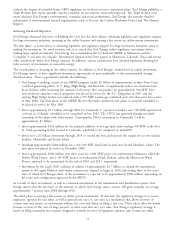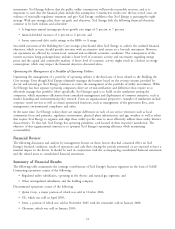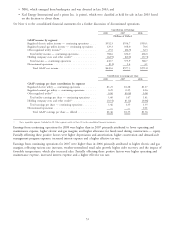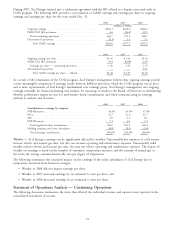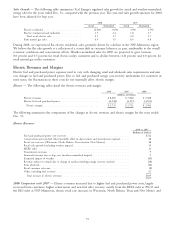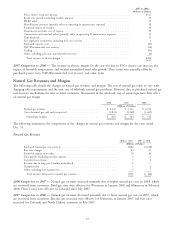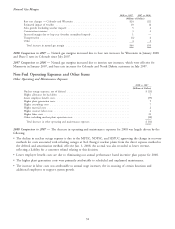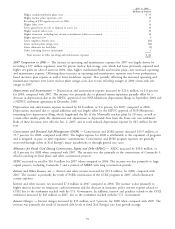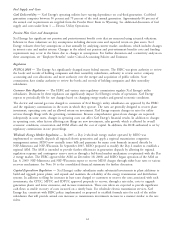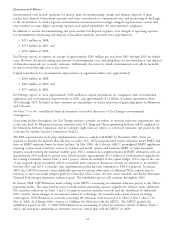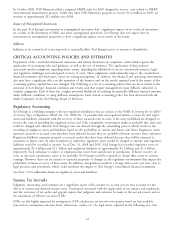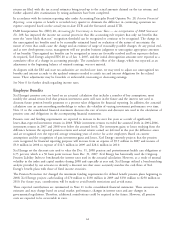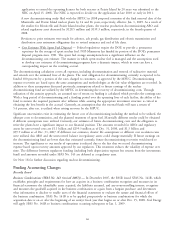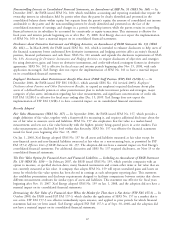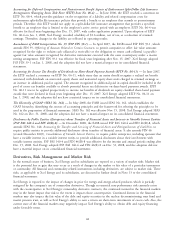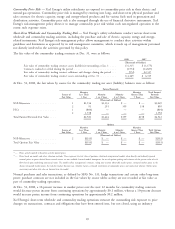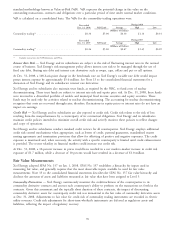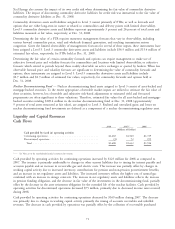Xcel Energy 2008 Annual Report Download - page 71
Download and view the complete annual report
Please find page 71 of the 2008 Xcel Energy annual report below. You can navigate through the pages in the report by either clicking on the pages listed below, or by using the keyword search tool below to find specific information within the annual report.Fuel Supply and Costs
Coal Deliverability — Xcel Energy’s operating utilities have varying dependence on coal-fired generation. Coal-fired
generation comprises between 56 percent and 79 percent of the total annual generation. Approximately 84 percent of
the annual coal requirements are supplied from the Powder River Basin in Wyoming. See additional discussion of fuel
supply and costs under Item 1 — Electric Utility Operations.
Pension Plan Costs and Assumptions
Xcel Energy has significant net pension and postretirement benefit costs that are measured using actuarial valuations.
Inherent in these valuations are key assumptions including discount rates and expected return on plan assets. Xcel
Energy evaluates these key assumptions at least annually by analyzing current market conditions, which includes changes
in interest rates and market returns. Changes in the related net pension and post-retirement benefits costs and funding
requirements may occur in the future due to changes in assumptions. For further discussion and a sensitivity analysis on
these assumptions, see ‘‘Employee Benefits’’ under Critical Accounting Policies and Estimates.
Regulation
PUHCA 2005 — The Energy Act significantly changed many federal statutes. The FERC was given authority to review
the books and records of holding companies and their nonutility subsidiaries, authority to review service company
accounting and cost allocations, and more authority over the merger and acquisition of public utilities. State
commissions have similar authority to review the books and records of holding companies and their nonutility
subsidiaries.
Customer Rate Regulation — The FERC and various state regulatory commissions regulate Xcel Energy’s utility
subsidiaries. Decisions by these regulators can significantly impact Xcel Energy’s results of operations. Xcel Energy
expects to periodically file for rate changes based on changing energy market and general economic conditions.
The electric and natural gas rates charged to customers of Xcel Energy’s utility subsidiaries are approved by the FERC
and the regulatory commissions in the states in which they operate. The rates are generally designed to recover plant
investment, operating costs and an allowed return on investment. Xcel Energy requests changes in rates for utility
services through filings with the governing commissions. Because comprehensive general rate changes are requested
infrequently in some states, changes in operating costs can affect Xcel Energy’s financial results. In addition to changes
in operating costs, other factors affecting rate filings are new investments, sales growth, which is affected by overall
economic conditions, conservation and DSM efforts and the cost of capital. In addition, the ROE authorized is set by
regulatory commissions in rate proceedings.
Wholesale Energy Market Regulation — In 2005, a Day 2 wholesale energy market operated by MISO was
implemented to centrally dispatch all regional electric generation and apply a regional transmission congestion
management system. MISO now centrally issues bills and payments for many costs formerly incurred directly by
NSP-Minnesota and NSP-Wisconsin. In September 2007, MISO proposed to modify the Day 2 market to establish a
regional ASM. The ASM is intended to provide further efficiencies in generation dispatch by allowing for regional
regulation response and contingency reserve services through a bid-based market mechanism co-optimized with the Day
2 energy market. The FERC approved the ASM on December 18, 2008, and MISO began operation of the ASM on
Jan. 6, 2009. NSP-Minnesota and NSP-Wisconsin expect to recover MISO charges through either base rates or various
recovery mechanisms. See Note 16 to the consolidated financial statements for further discussion.
Capital Expenditure Regulation — Xcel Energy’s utility subsidiaries make substantial investments in plant additions to
build and upgrade power plants, and expand and maintain the reliability of the energy transmission and distribution
systems. In addition to filing for increases in base rates charged to customers to recover the costs associated with such
investments, the CPUC, MPUC and SDPUC approved proposals to recover, through a rate rider, costs to upgrade
generation plants and lower emissions, and increase transmission. These rate riders are expected to provide significant
cash flows to enable recovery of costs incurred on a timely basis. For wholesale electric transmission services, Xcel
Energy has, consistent with FERC policy, implemented or proposed to establish formula rates for each of the utility
subsidiaries that will provide annual rate increases as transmission investments increase in a manner similar to the rate
riders.
61


